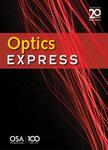版权所有:内蒙古大学图书馆 技术提供:维普资讯• 智图
内蒙古自治区呼和浩特市赛罕区大学西街235号 邮编: 010021

作者机构:Nankai Univ Inst Modern Opt Coll Elect Informat & Opt Engn Tianjin 300350 Peoples R China Tianjin Key Lab Microscale Opt Informat Sci & Tech Tianjin 300350 Peoples R China Nankai Univ Sch Phys MOE Key Lab Weak Light Nonlinear Photon Tianjin 300457 Peoples R China Nankai Univ TEDA Appl Phys Inst Tianjin 300457 Peoples R China Tianjin Univ State Key Lab Precis Measurement Technol & Instrum Tianjin 300072 Peoples R China
出 版 物:《OPTICS EXPRESS》 (Opt. Express)
年 卷 期:2024年第32卷第5期
页 面:7171-7184页
核心收录:
学科分类:070207[理学-光学] 07[理学] 08[工学] 0803[工学-光学工程] 0702[理学-物理学]
基 金:National Natural Science Foundation of China [62075104 61775105]
主 题:Field enhancement Finite-difference time-domain method Light matter interactions Optical antennas Optical fields Optical force
摘 要:We propose an efficient method for calculating the electromagnetic field of a largescale array of optical nanoresonators based on the coupling theory of quasinormal mode (QNM). In this method, two approaches of the scattered-field reconstruction and stationary-phase-principle calculated plane-wave expansion are developed to obtain the regularized QNM (RQNM) in different regions. This accurate and efficient calculation of RQNM resolves the far-field divergence issue of QNMs in the QNM-coupling theory, thus enabling a rapid computation of the electromagnetic field of a large-scale array of optical nanoresonators, which is a challenging task for full-wave numerical methods. Using this method, we consider the numerical example of the radiation problem of a single point source in a large-scale periodic array of optical nanoantennas. In comparison to full-wave numerical methods, this method significantly reduces the computation time by 1 similar to 2 orders of magnitude while maintaining accuracy. The high computational efficiency and physical intuitiveness of the method enables to clarify the impact of array size (exceeding 50 x 50 wavelengths), period and field-coupling range (far beyond the tight-binding approximation) on the optical response. The proposed method and results can provide an efficient tool and guidance for the design of large-scale arrays of optical nanoresonators.